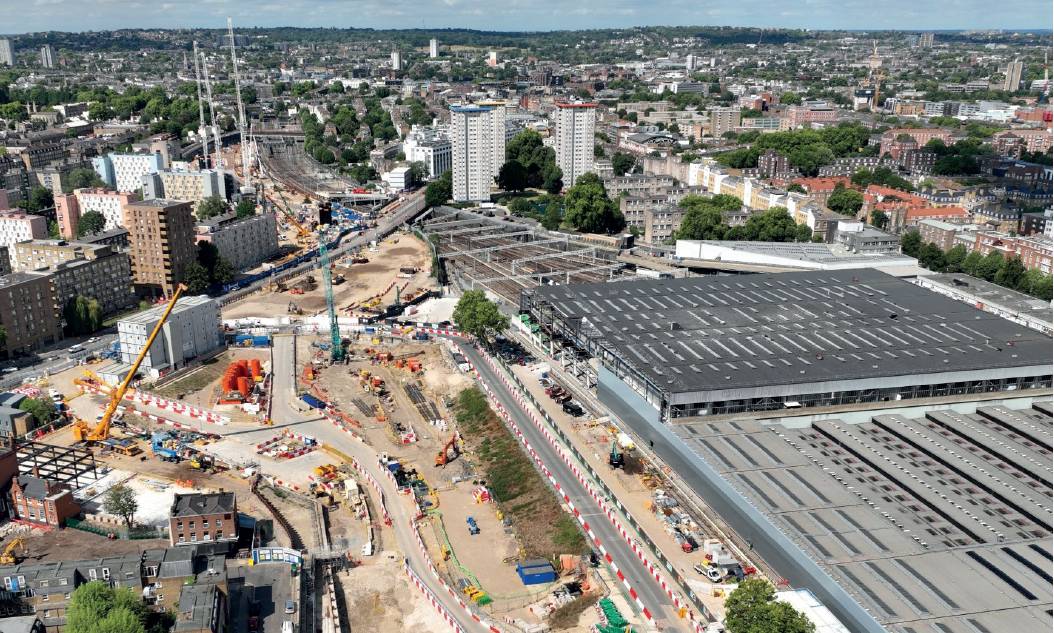The biggest issues of the month explored | High Speed 2
Inside Track
HIGH SPEED 2
Where to now HS2 journey stutters to a halt?
Call for more coherent infrastructure planning after line’s northern section axed
By Rob Hakimian
Senior engineers say prime minister Rishi Sunak’s decision to significantly scale down High Speed 2 (HS2) means that its northern legs will never be built.
On 4 October Sunak announced he was cancelling the northern section of High Speed 2 (HS2) between London and Manchester, slashing capacity at the Euston terminus removing safeguards protecting the route. He said the decision was made because costs were running out of control. The project was originally budgeted at £56bn in 2015 and costs are now expected to be £100bn.
 HS2’s Euston terminus has been scaled back even further
HS2’s Euston terminus has been scaled back even further
The decision has halted preparatory work for the line between Birmingham Manchester and the East Midlands.
The industry said the news undermined efforts to plan infrastructure provision. ICE policy director Chris Richards said that “the lesson from today’s announcement on HS2 is the UK must change how it approaches planning and delivering infrastructure”.
He added: “We need long term plans, supported by evidence, long term thinking on financing options and robust and consistent policy to achieve desired outcomes […]. These positive outcomes are how we should be measuring success, not just by lowest cost to deliver.”
National Infrastructure Commission chair and ICE past president Sir John Armitt noted that the cancellation will be “leaving a major gap in the UK’s rail strategy around which a number of city regions have been basing their economic growth plans”.
Independent rail consultant William Barter worked with project promoter HS2 Ltd and the Department for Transport (DfT) on timetabling for the project. He called what remains of HS2 a “minimum viable product”, adding that “it can hardly be said to represent a good long term choice”.
The government confirmed HS2’s beleaguered London terminus at Euston will be completed – but under the management of new government-appointed body called Euston Square Development Company, instead of HS2 Ltd.
The new plan is for a six-platform station surrounded by a housing development “potentially offering up to 10,000 homes” according to the DfT’s Network North document published to outline proposals for the scaled-back project.
But the Euston terminus was initially to have 11 platforms and a decision to reduce this to 10 had already hampered future service capacity.
Earlier this year the government suspended the Euston terminus project for two years – after the expected cost had hit £4.8bn compared to an original budget of £2.6bn. At that time it was revealed that the DfT was considering reducing the number of platforms to seven.
Engineers told NCE that the seven-platform configuration was unsuitable for the future high speed network. It is thought six platforms will make later attempts to extend the line from Birmingham to Manchester, Nottingham or Leeds even less viable.
Barter said: “ideally, the station would be configured to make addition of further platforms possible” so that once-promised high speed services to the Midlands and North could be delivered in future. But there is no suggestion in the Network North document that this is the case.
HS2 was initially expected to run 17 trains an hour from Euston to locations including Liverpool, Manchester and Glasgow, with trains initially running on standard tracks north of Birmingham. Now the HS2 service is only expected to run a maximum of 10 trains an hour between London and Birmingham.
The government said earlier this year that it is unlikely that the Euston terminus will be ready in time for the start of HS2 services to Birmingham, meaning that the southern terminus will initially be at Old Oak Common in west London.
The fact that HS2 will not run to Manchester will have a knock-on effect for Northern Powerhouse Rail – the high speed line that is to connect cities across the North of England from Liverpool to Hull via Manchester and Leeds. Interchanges with Northern Powerhouse Rail were included in the now-abandoned plans for the northern leg of HS2.
Meanwhile, the DfT announced that safeguards to the route in Cheshire, Derbyshire, Lancashire, Leicestershire, Nottinghamshire, Staffordshire, Warwickshire and Yorkshire will be lifted “at the earliest opportunity” meaning that this land designated for the line will be made available for non-HS2 developments.